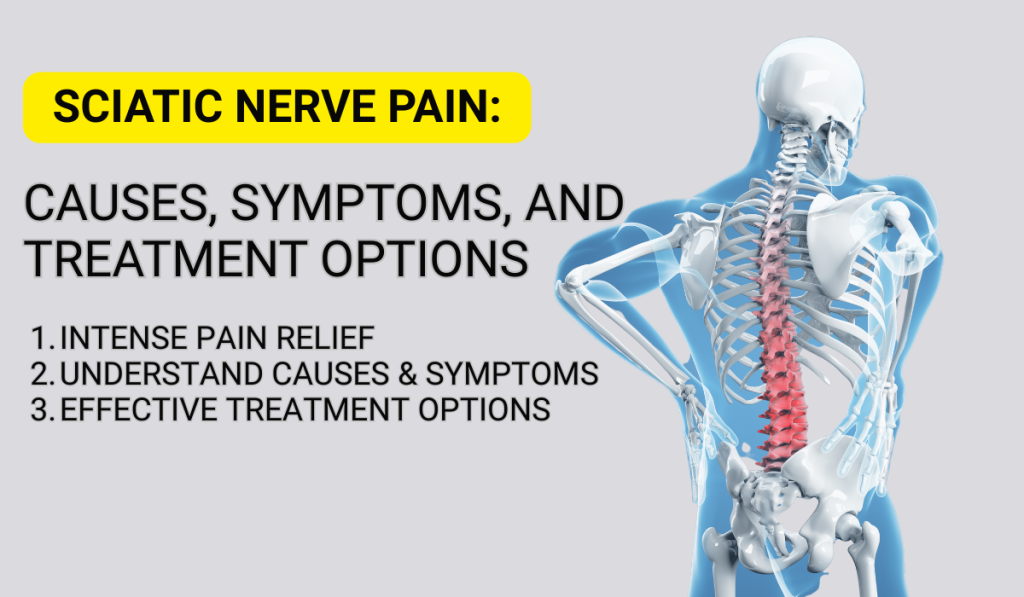Sciatic Nerve Pain Relief: Understanding and Managing Sciatica

What is Sciatic Nerve Pain Relief?
Sciatica refers to pain that radiates along the path of the sciatic nerve, which extends from the lower back through the hips and buttocks and down each leg. This pain often arises from conditions affecting the lower back, resulting in significant discomfort and mobility challenges.
Thank you for reading this post, don't forget to subscribe!Causes of Sciatic Nerve Pain
Understanding the causes of sciatic nerve pain is essential for effective management. Common causes include:
- Herniated Discs: Discs that bulge or rupture can compress the sciatic nerve, leading to lower back pain and discomfort.
- Bone Spurs: Overgrowths of bone can exert pressure on the sciatic nerve.
- Spinal Stenosis: Narrowing of the spinal canal can lead to nerve compression and pain.
- Muscle Strain: Injuries or strains in the lower back or hips can aggravate the sciatic nerve.
Recognizing Symptoms of Sciatic Nerve Pain Relief
Sciatica symptoms can vary widely among individuals, but there are several common experiences that many people report. Understanding these symptoms can help in identifying the condition early and seeking appropriate treatment. Here are the key symptoms to watch for:
- Lower Back Pain: Many individuals with sciatica experience pain that originates in the lower back. This discomfort can range from a dull ache to a sharp, stabbing sensation. The pain may worsen with certain movements, such as bending or twisting, and can radiate down the legs, making it difficult to maintain a comfortable position.
- Extreme Sciatic Nerve Pain: This symptom is often described as an intense, sharp pain that feels like a jolt or electric shock. It typically affects one side of the body and can be triggered by prolonged sitting, standing, or sudden movements. This type of pain can be debilitating, significantly impacting daily activities.
- Hip Pain: Discomfort in the hip area is a common symptom of sciatica. This pain can vary in intensity and may accompany lower back pain. Some individuals may feel a deep ache in the hip joint, while others may experience sharp pain that radiates down the leg, contributing to overall discomfort.
- Numbness or Tingling: Many people report a pins-and-needles sensation in their legs or feet, which can accompany the pain of sciatica. This numbness can occur in various areas, often extending from the lower back down to the toes. It may be intermittent or persistent, and in some cases, it can lead to difficulty in feeling sensations in the affected leg.
- Muscle Weakness: Sciatica can cause significant muscle weakness in the affected leg, making it challenging to move or control the foot. This weakness can lead to difficulties with activities such as walking, climbing stairs, or standing up from a seated position. In severe cases, it can even result in a noticeable limp.
Recognizing these symptoms early can be crucial for effective management and treatment of sciatica. If you experience any of these signs, especially if they persist or worsen, it is important to consult a healthcare professional for further evaluation and guidance.
Sciatic Nerve Pain area
A sciatic nerve pain chart is a valuable tool for individuals seeking to understand the specific areas affected by sciatic nerve pain. This chart visually represents the common pathways of pain associated with sciatica, which typically follows a distinctive pattern. Here’s a breakdown of the areas involved:
- Lower Back: The journey of sciatic nerve pain often begins in the lower back, where individuals may experience discomfort that can range from a dull ache to an intense, sharp sensation. This pain can be exacerbated by certain movements, such as bending, lifting, or sitting for extended periods. In some cases, the pain may be accompanied by stiffness or a reduced range of motion, making everyday activities challenging.
- Buttocks: As the pain progresses, it may radiate into one or both buttocks. This discomfort can manifest as a deep, aching sensation that feels like it’s coming from the muscles rather than the joint. Some individuals report a burning or throbbing feeling in the buttocks, which can be particularly bothersome when sitting or standing. The pain may also affect one side more than the other, depending on the location of the nerve compression.
- Legs: The most distinctive feature of sciatica is the pain that travels down the back of the leg, often reaching the calf, ankle, or foot. This leg pain can be described as a sharp, shooting sensation or a deep ache, and it may vary in intensity. In some cases, individuals might experience symptoms like numbness or tingling in the legs or feet, making it difficult to walk or stand. This pattern of pain is typically unilateral, affecting one side more than the other, and can significantly impact mobility and quality of life.
In summary, understanding the sciatic nerve pain chart can provide insights into the condition’s progression and help individuals communicate more effectively with healthcare providers. Recognizing these patterns can also aid in identifying triggers and developing strategies for relief.
Effective Home Remedies for Sciatic Nerve Pain Relief
Managing sciatic nerve pain at home can be effective with the right strategies. Here are several remedies that can provide relief:
- Gentle Movement: Staying active is crucial for alleviating sciatic nerve pain. Engage in light activities such as walking, swimming, or cycling to maintain mobility and ease tension. Regular movement promotes circulation, reduces stiffness, and helps keep the muscles flexible. Incorporating short, frequent walks throughout the day can be particularly beneficial, as it avoids prolonged pressure on the sciatic nerve.
- Cold and Heat Therapy: Utilizing cold and heat can significantly reduce pain and inflammation. Apply ice packs to the affected area for 15–20 minutes several times a day, especially during the initial stages of pain. This helps numb the area and reduce swelling. After 48 hours, switch to heat therapy using a heating pad or warm compress, which can relax tight muscles and improve blood flow, further aiding in pain relief.
- Over-the-Counter Pain Relievers: Nonsteroidal anti-inflammatory drugs (NSAIDs) like ibuprofen (Advil) or naproxen sodium (Aleve) can be effective in managing pain and inflammation. These medications help reduce discomfort, making it easier to engage in physical activity. However, it’s important to use them as directed and consult a healthcare provider if you have any underlying health conditions or are taking other medications.
- Stretching Exercises: Gentle stretching can relieve pressure on the sciatic nerve and improve flexibility. Incorporate stretches that target the lower back, hips, and hamstrings. Effective stretches include the piriformis stretch, knee-to-chest stretch, and hamstring stretches. Hold each stretch for 15-30 seconds and repeat several times, being mindful to avoid any movements that exacerbate your pain.
- Mindfulness and Relaxation Techniques: Psychological stress can contribute to muscle tension, worsening sciatic pain. Practices such as mindfulness meditation, deep breathing exercises, and progressive muscle relaxation can help reduce stress and promote relaxation. Incorporating yoga or tai chi into your routine can also improve flexibility and strengthen the muscles that support the spine.
- Ergonomic Adjustments: Evaluate your workspace and daily activities to ensure ergonomic support. When sitting for prolonged periods, use a chair that provides good lumbar support, and consider using a cushion to relieve pressure on the lower back. Adjust your workstation to maintain good posture, keeping your feet flat on the floor and your knees at a right angle.
- Hydration and Nutrition: Staying well-hydrated and maintaining a balanced diet can contribute to overall musculoskeletal health. Adequate hydration helps keep spinal discs lubricated, and a diet rich in anti-inflammatory foods—such as fruits, vegetables, and omega-3 fatty acids—can aid in reducing inflammation and promoting healing.
- Sleep Position Adjustments: Your sleeping position can significantly affect sciatic nerve pain. Consider sleeping on your side with a pillow between your knees to maintain spinal alignment, or on your back with a pillow under your knees for added support. These adjustments can help relieve pressure on the sciatic nerve during sleep.
Implementing these home remedies can provide significant relief from sciatic nerve pain and improve your overall quality of life. However, if symptoms persist or worsen, it’s essential to consult a healthcare professional for further evaluation and guidance.When to Seek Medical Help
While many individuals can effectively manage sciatica at home through various remedies, there are specific circumstances in which medical intervention is necessary. Recognizing these signs is crucial for ensuring appropriate care and preventing complications:
- Pain Is Severe: If you experience extreme sciatic nerve pain that disrupts your daily life and activities, it’s essential to consult a healthcare professional. Pain that is unmanageable, persistent, or worsening despite home treatments may indicate a more serious underlying condition that requires medical attention.
- Loss of Sensation: Numbness or weakness in the legs or feet that affects your ability to move or control your limbs is a critical warning sign. If you notice significant changes in sensation or strength, such as difficulty lifting your foot or feeling unable to bear weight on one leg, seek medical help. These symptoms can indicate nerve damage or severe compression that may necessitate prompt treatment.
- Bladder or Bowel Issues: Experiencing difficulty controlling your bladder or bowel function is a serious concern and may indicate a condition known as cauda equina syndrome. This rare but severe condition requires emergency medical attention, as it can lead to permanent nerve damage if not treated promptly.
- Progressive Symptoms: If your symptoms are worsening over time, or if you start to experience new symptoms, such as increased pain, tingling, or weakness that spreads, it’s important to seek evaluation. Progressive symptoms can indicate a deteriorating condition that requires further investigation.
- Inability to Perform Daily Activities: If sciatica prevents you from performing basic daily activities—such as walking, sitting, or sleeping—effectively, it may be time to consult a healthcare provider. Persistent pain that interferes with your quality of life should not be ignored.
- Previous Treatments Have Failed: If you’ve tried various home remedies or over-the-counter treatments without relief, it’s advisable to seek professional help. A healthcare provider can offer alternative treatment options, including physical therapy, prescription medications, or imaging studies to assess the underlying cause of your pain.
Recognizing when to seek medical help can make a significant difference in the management of sciatica. Early intervention can lead to more effective treatment and a better prognosis, so don’t hesitate to reach out to a healthcare professional if you have concerns.
Sciatic nerve pain relief: The Impact of thyrovanz
For many individuals struggling with sciatic nerve pain, finding an effective solution can be a challenge. One product that has gained attention for its potential to alleviate discomfort is thyrovanz. This innovative device is designed to provide targeted relief for sciatic pain and other related conditions.
thyrovanz utilizes a unique approach to pain management by combining gentle pressure and vibration to relax tight muscles and promote circulation in the affected areas. Many users have reported positive experiences, noting improvements in mobility and a reduction in pain levels after incorporating this device into their routine.
It’s worth considering that while products like thyrovanz may help, they should be part of a comprehensive approach to managing sciatic nerve pain. This includes consulting with healthcare professionals, engaging in physical activity, and employing various home remedies. To explore more about thyrovanz and see if it could be beneficial for your situation, you can visit the official website for additional information and user testimonials.
Conclusion
Sciatic nerve pain, or sciatica, can significantly impact quality of life. Understanding the causes, symptoms, and effective management strategies is crucial for relief. If home remedies do not alleviate your pain, consider consulting a healthcare professional for a tailored treatment plan.


